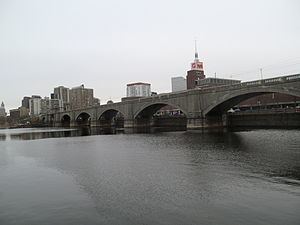Carries Light rail No. of spans 12 Opened 1 June 1912 | Crosses Charles River Construction begin June 20, 1907 Total length 518 m Carry Light rail | |
 | ||
Similar Tremont Street Subway, Buzzards Bay station, Lechmere, Hynes Convention Center, Waban | ||
The Lechmere Viaduct is a concrete arch bridge connecting the West End neighborhood of Boston to East Cambridge, Massachusetts. Opened in 1912, the viaduct carries the MBTA's Green Line over the Charles River. It is adjacent to the Charles River Dam Bridge, but structurally separate.
Contents
Construction
When the Tremont Street Subway fully opened in 1898, surface cars entering the subway from East Cambridge had to cross Craigie's Bridge and proceed on surface streets to the Canal Street Incline. The trip from Lechmere Point over the bridge was slow and prone to delays. On June 20, 1907, construction began on one mile of elevated track connecting the Canal Street Incline to East Cambridge. The project's centerpiece was the 1,700-foot (520 m) arched viaduct crossing the Charles River, with 12 spans including a short drawbridge section.
Other sections of elevated track included the Causeway Street Elevated on the Boston side of the river, and the Lechmere Elevated on the East Cambridge side. The first streetcars crossed the bridge in revenue service on June 1, 1912, shortening the ten-minute trip from Lechmere Square to the subway to just three minutes. The building of the massive structure was done entirely by the Boston Elevated Railway, without use of subcontractors.
The BERy opened Lechmere station on July 10, 1922, as a transfer point between the Cambridge streetcars and the subway cars. This prevented traffic delays affecting the surface cars from propagating into the subway, and allowed the underground service to use three-car trains, which were too long for safe street-running.
On August 20, 1955, Science Park station opened as an infill station on the viaduct over Leverett Circle. It serves the Boston Museum of Science and the West End.
Service disruptions
On June 25, 2004, service over the viaduct was suspended as the Causeway Street Elevated was removed, and the surface and elevated platforms at North Station were consolidated into a new underground "superstation". This left the Lechmere Viaduct and Lechmere Elevated as the sole remaining elevated lines in Boston. A new portal was built off Martha Road, with a new concrete bridge connecting to the viaduct just south of Science Park station. Service to Lechmere resumed on November 12, 2005. The incline from the 2005-built tunnel to the Lechmere Viaduct is the steepest grade on the entire MBTA subway system. The viaduct was again closed from April 30 to November 4, 2011, as Science Park station was rebuilt with handicapped-accessible platforms and new elevators.
As part of the Green Line Extension project, the northern section of the Lechmere Elevated will be removed and the elevated section of the line will be extended to a large flyover bridge crossing the Fitchburg Line tracks. The 1922-built original Lechmere terminal will be replaced with a new elevated station across the street. The work may require closing the viaduct (and thus cutting service back to North Station) for 17 months, a disruption which has been opposed in Cambridge.
Only the Green Line "E" Branch service currently uses the viaduct; the "B", "C", and "D" branches terminate in downtown Boston. When the Green Line Extension is complete, the "D" branch will run across the viaduct to College Avenue, and the "E" Branch will operate to Union Square. Additional service may operate to Lechmere during construction of the Extension as mitigation for delays.
